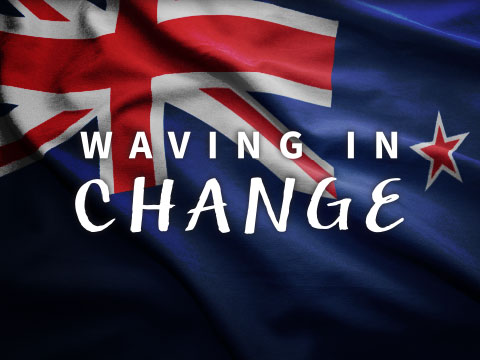Waving in Change

As designers many of us dream of the day we might be given the opportunity to design a new logo or reimagine core brand work for one of the ‘big three’ - Coca-Cola, McDonalds, Nike. Even if you don’t agree with their practices or ethics, the thought of having your work reach every corner of the world and be seen by billions of eyes is the stuff of dreams. But what would your reaction be if a bona fide, English speaking country came to you and said “you know what, we don’t like our brand; and we really feel like our logo is letting us down”.
Hello New Zealand.
Since the 70’s there has been an internal battle over how they want to be perceived. They no longer want to be deemed as ‘just a colony of Britain’ but a country in their own right, and now realise more than ever that they need to recognise their true heritage and Maori roots; alas a shiny new flag is in the works.
Now at this point the process differs from the usual rebranding job. New Zealand as a country opened the competition up to anyone with the ability to use MS Paint. Is this the fair thing to do? Yes, this is a country that makes up a part of the world, so why shouldn’t everyone have go at it. But is it really the right way to go about a project of this size and scope? Maybe... yeah... kinda... no.
The problem here is, without a real brief, true insight and a strong proposition, are the New Zealand government really making it possible to get the best out of their leagues of worldwide ‘designers’.
Their brief does ask that participants follow the top 5 rules of the North American Vexilloloigcal Association (Vexillology is the scientific study of the history, symbolism and usage of flags or, by extension, any interest in flags in general) - the rules are as follows:
1. Keep it simple 2. Use meaningful symbolism 3. Use two to three basic colors
4. No lettering or seals of any kind 5. Be distinctive
The final four as chosen by New Zealanders
I don’t want to get in the way of creativity; if little Kieran from Auckland Primary School wants to throw his hat in the ring then fair enough. But if New Zealand was thinking like a big business would this really be the design route they would have taken? Or is big business going about this all wrong? Maybe every logo or rebrand should be designed by the masses then put to up for popular vote, putting social media (finally) to some sort of use and good in the world.
Are we encouraging a new generation of designers to take out a notebook and pen and scamp out a few simple thoughts with the promise of having your final design put on the world stage? Or are we denigrating scores of designers who have spent years working feverishly for their trade? Luckily, wired.co.uk have already put some thought into this from a post in 2012. “Successful design work results from a collaborative process between a client and the designer, developing a clear sense of the client’s objectives, competitive situation, and needs. Speculative design competitions result in a superficial assessment of the problem and can only result in a design that is judged on a superficial basis.
Design creates value for clients as a result of the approach designers take in addressing theproblems or needs of the client and only at the end of that process is a “design” created. Speculative competitions for work based on a perfunctory problem statement will not result in the kind of work a client deserves.” Couldn’t have said it better myself, but I am biased.
Up to this point I’ve only assumed that New Zealand didn’t approach one of the many reputable design or branding agencies in New Zealand or elsewhere around the globe - and maybe they didn’t feel like taking on such a task. Only recently we’ve seen huge public backlash with regards to the overhauling of the Yahoo! logo (although that was done in-house), and this example sits neatly on the top of the huge pile of ‘failed’ redesigns. Imagine the entire population of New Zealand turning up to your office and doing the Haka in reception - I don’t think anyone in that agency would leave at the end of the day without a change of pants!
But, I still don’t see anyone within a creative agency turning this job down. If it goes sour you just say that you followed the brief and worked closely with the client towards a result you were both happy with, and then wait for the London 2012 moment where the populous turns around two years later and actually quite likes it. And if it all goes well with two thumbs up.... then you’re laughing all the way to the bank, you just redesigned a country.
So essentially what’s my point here. Well just a really long and rambling way of saying shouldn’t we just leave the brief to the account handlers, designing to the designer and the strategy to the strategists.
Written by
Laura Walkerdine, Senior Designer